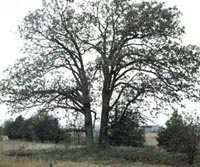Resource Library
Plant of the Week: Post Oak
The University of Arkansas System Division of Agriculture does not promote, support or recommend plants featured in "Plant of the Week." Please consult your local Extension office for plants suitable for your region.
Plant of the Week
Post Oak
Latin: Quercus stellata

Taxes or trees? The recent decision of the Fayetteville City Board to create an exception
to its own laws on tree protection so that a department store can build in northwest
Arkansas has angered a lot of the residents of the city.
The board's 5-to-4 decision has spawned a tree sitter and a petition drive avowing
a boycott against the chain store before it even opens.
The trees at the center of this controversy are a Civil War age stand of about 80
post oaks that many feel deserve protection, not because the species is rare, but
because of their massive size. These trees are about 100 feet tall with trunk diameters
approaching 36 inches. They stand in a widely spaced grove with grass beneath and
are a glimpse back to what Fayetteville was like prior to the Civil War.
Waterman Ornsby, a newspaper man who rode through Fayetteville in 1858 on the Butterfield
Overland Stage on its first trip to San Francisco, characterized the city as a "prairie
in the mountains." He describes the widely spaced post oak groves as open areas with
no undergrowth that remind him of driving through an orchard.
Post oaks are not trees of commerce. They grow too slowly and their transplant survival
is too poor for the nurseryman to deal with. As a member of the white oak subgenus
they are able to attain considerable age. In open prairie, stands a 300-year-old specimen
would be a grande dame, but on a dry, rocky upland site, a tree twice that age but
a fourth the size might be found.
The argument of development versus environment is an old one and usually takes the
guise of "jobs (or tax revenue for the city) or trees -- you can’t have them both."
The same argument was made by the corporate world about water and air pollution regulations
a generation ago, but by all indications business has flourished under these types
of environmental regulations. If good planning is used it is possible to preserve
trees and still enjoy a healthy business atmosphere. If trees are to be saved the
engineering and architectural team in charge must look at the site and modify the
plan in compliance with tree protection regulations.
Zoning regulations, and the tree protection provisions that fall under the large
scale development phase of the ordinances, are often considered an infringement on
private property rights by developers. But the citizens and the courts have long held
that reasonable and evenly applied zoning regulations are in the best interest of
a community and are defensible.
Environmental protection and preservation ordinances are newer than general zoning
ordinances and developers are often given a pass in following the letter of the regulation.
Keeping old trees alive during construction is a pretty simple proposition. Basically,
they must be left undisturbed with enough root room to provide for their long term
support. The area must be cordoned off and no vehicle access allowed. Also, the natural
drainage conditions of the site must not be drastically changed or the trees may drown
from impounded water. Trees such as the post oaks under discussion here have roots
that extend about twice the height of the tree in all directions. While maintaining
the area beneath the drip line is a start, such meager protection probably will not
be enough to see the trees survive another century.
By: Gerald Klingaman, retired
Extension Horticulturist - Ornamentals
Extension News - May 19, 2000
The University of Arkansas System Division of Agriculture does not maintain lists of retail outlets where these plants can be purchased. Please check your local nursery or other retail outlets to ask about the availability of these plants for your growing area.